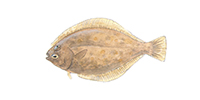Thank you for visiting the Seafood Selector. EDF is planning a new approach to providing information to consumers about good seafood choices. Please come back soon for updates.
Flounder/Sole

Pacfic Sanddab/Flounder, © Amadeo Bachar
Recommended servings per month
| Contaminant | Men | Women | Kids 6-12 | Kids 0-5 | |
|---|---|---|---|---|---|
| Starry flounder (US, Pacific) | 4+ | 4+ | 4+ | 4+ | |
| American plaice (US, Atlantic) | Mercury | 4+ | 4+ | 4+ | 4+ |
| Summer flounder (US, Atlantic) | Mercury | 4+ | 4+ | 4+ | 4+ |
| Winter flounder | Mercury | 4+ | 4+ | 4+ | 4+ |
| Witch flounder | Mercury | 4+ | 4+ | 4+ | 4+ |
| Yellowtail flounder | Mercury | 4+ | 4+ | 4+ | 4+ |
| Pacific sanddab | Mercury | 4+ | 4+ | 4+ | 4+ |
| Dover sole | Mercury | 4+ | 4+ | 4+ | 4+ |
| English sole | Mercury | 4+ | 4+ | 4+ | 4+ |
| Petrale sole | Mercury | 4+ | 4+ | 4+ | 4+ |
| Rex sole | Mercury | 4+ | 4+ | 4+ | 4+ |
| Yellowfin sole | Mercury | 4+ | 4+ | 4+ | 4+ |
| Windowpane flounder (US, Atlantic) | 4+ | 4+ | 4+ | 4+ | |
| Blackback flounder (US, Atlantic) | 4+ | 4+ | 4 | 4+ | |
| Arrowtooth flounder (US and Canada, Pacific) | 4+ | 4+ | 4+ | 4+ |
Eco details:
- Since they live on or near the bottom, flounder and sole are usually caught by bottom trawls, which can result in bycatch and damage to bottom habitats.
- True flounders are found in the Atlantic Ocean and Gulf of Mexico. In New England, flounders are now caught under an innovative new ‘sector’ management plan. Discards in the fishery have dramatically decreased, sector fishermen stayed under their catch limits for all groundfish species, and less gear was deployed compared to previous years.
- True soles are found in the Pacific Ocean. On the West Coast, soles are now managed under an innovative new ‘catch share’ management plan. Bycatch is down 75%, and conservative catch quotas have limited the catch of overfished rockfish. Additionally, an innovation boom in gear design and fishing behavior has helped trawlers avoid bycatch hotspots and keep sensitive species out of nets.




